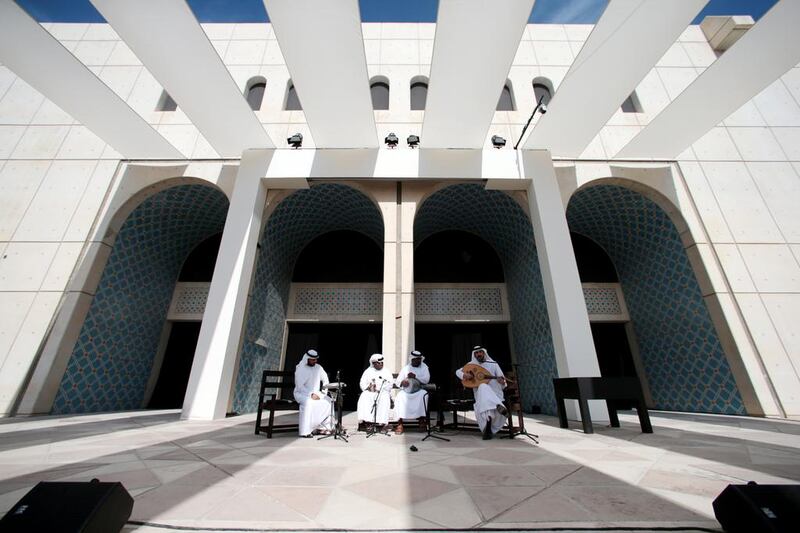After several years in which its future seemed uncertain, 2014 was something of an annus mirabilis for the Abu Dhabi Cultural Foundation.
Not only was the building opened to the public for the first time in five years during last year’s Qasr Al Hosn Festival, but it also made a remarkable double appearance at the Venice Biennale’s 14th International Architecture Exhibition.
Both the United States and the UAE chose the National Library and Cultural Centre (as the Abu Dhabi Cultural Foundation was once known) as a reference point in their exploration of Absorbing Modernity 1914-2014, one of three themes devised for the Biennale by its director Rem Koolhaas.
Through Absorbing Modernity, the Dutch architect and theorist – the man responsible for books such as Delirious New York and buildings such as the Seattle Central Library – asked participating nations to explore the last century of their architectural history.
Deliberately broad and open to interpretation, Absorbing Modernity nevertheless raised issues about globalisation, nationhood, conservation and identity that are directly pertinent to contemporary heritage debates in the UAE, something that was recognised in the UAE's national pavilion Lest We Forget: Structures of Memory in the UAE.
Commissioned by the Salama bint Hamdan Al Nahyan Foundation and curated by the American art historian Michele Bambling, the pavilion has now been brought back to Abu Dhabi and is being exhibited inside the Cultural Foundation as part of this year’s Qasr Al Hosn Festival.
Exhibited for the first time since Venice, the installation presents the Cultural Foundation as one of the foremost examples of modern architectural heritage in the UAE and – in keeping with its non-hierarchical approach – displays architectural drawings, models and professional opinions alongside personal recollections, ephemera such as invitations and leaflets, and even home movies.
The effect is a rare “vernacular” history of architecture that explains not only how and why buildings were produced, but also how the buildings were experienced.
“When I came back from London, I didn’t have a place to go to meet artists and to show my artwork. The Cultural Foundation is the place where I exhibited my work for the first time,” remembers the Emirati artist and jewellery designer Azza Al Qubaisi.
Lest We Forget uses timelines to situate UAE buildings alongside international architectural developments and political events, but its value lies in the detailed insight it provides into local issues that have a wider resonance, as might be expected from a project focused on memory.
“It is a function of this place of rapid change that there are disappearances. It happens all the time that we find a place and six months later it is gone,” Kevin Mitchell, professor of architecture and vice chancellor of the American University of Sharjah, explains in the installation. “In a way, memory is something to hold on to that counters transience. Expatriates live in transience, in that we come and go. The citizen population lives and experiences transience in the drastic change of urban development.”
The perspective taken by the other Venice Biennale pavilion to exhibit the Cultural Foundation, the United States's OfficeUS, was very different. It took as its subject the work of the US architectural firm The Architects Collaborative: the firm won an international competition to design what would become the Cultural Foundation and went on to oversee its completion in 1981.
“We wanted to look at the history of US architecture firms over the past 100 years in terms of how they practised, how they were structured, how they produced the work they produced and to look at that through the lens of the work they produced outside of the US,” says Michael Kubo, the associate curator for OfficeUS and a doctoral student at MIT whose research has focused on the history of TAC. “There were a series of issues or narratives that we identified as one moved through the chronology through the past 100 years and one of the main narratives was US architecture firms working in the Middle East and very heavily in the Gulf States.
“It begins in the 1950s and by the time you get to the oil boom, especially between ’73 and ’83, really a huge amount of architecture practice in the United States is all flowing through the Middle East and TAC was one of the offices that was working most heavily in the Middle East.”
The "repository" of projects that Kubo helped to assemble for OfficeUS included 22 TAC projects such as Abu Dhabi's National Library and Cultural Centre and the Hotel InterContinental Sharjah, but started with Walter Gropius and Hisham Mounir's University of Baghdad (1957-83), the project that effectively launched the practice in the region.
“TAC grew to be a very large office after the 1950s in large part because of the volume of work they were doing in the Gulf States but it also killed them,” Kubo explains. “At their peak, in 1980, they had 380 employees but after 1983, the end of the oil boom and the collapse of their work in Iraq and Kuwait, that was the beginning of the end. They went bankrupt in 1995.
“It’s impossible to tell the story of the practice and their growth and change over time without talking about all of the work they were doing in the Middle East,” the historian insists.
Not only is TAC’s National Library and Cultural Centre bracketed perfectly by the years of the oil boom – the competition was launched in 1973 and the building was finally opened in 1981 – but it also illustrates a particular moment in the history of architecture in the United States that has been either ignored or denigrated in the past.
“There’s been a tendency in the West to look at these offices divorced from their work, especially in the Middle East, and either to be unaware of the work that firms like TAC were doing in the Middle East, or to dismiss it as being less relevant.”
Kubo considers the reactions of architectural historians and critics such as Charles Jencks and Manfredo Tafuri as being fairly typical of the work’s reception in Europe and North America during the 1970s and 1980s. For Tafuri, projects such as the University of Baghdad, which TAC started in 1957, were “typical American export products with their puerile environmental touches, which in reality are strictly from Disney”.
For Kubo, however, the Middle Eastern work of offices such as Hellmuth, Obata and Kassabasum, Skidmore, Owings and Merrill, Caudill Rowlett Scott and TAC not only sheds light on the emergence of a form of large-scale, mainstream professional practice in the US that continues to this day, but also plays a vital role in understanding the broader history of US architecture in the period.
“The Cultural Foundation can provide a link not just to the history of TAC in the Middle East, but to a whole group of US offices that were practising in the same period, not just in Abu Dhabi but elsewhere.
“Looking at the history of these buildings is as important for understanding the history of architecture firms in the US as it is for understanding what it meant in cities like Abu Dhabi.”
nleech@thenational.ae






